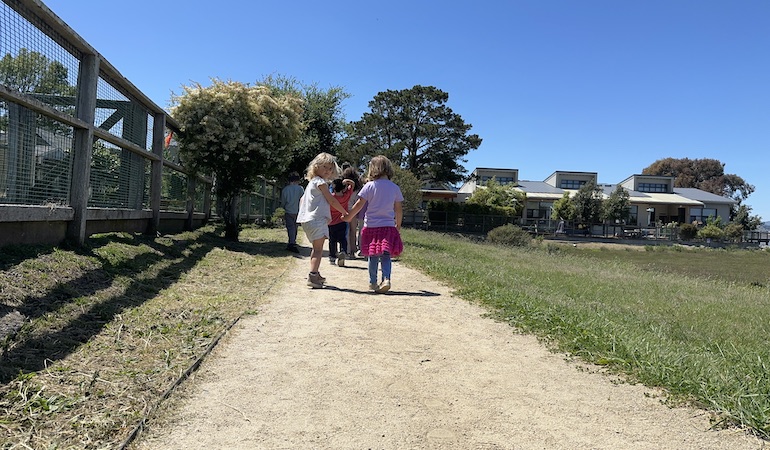Every day, I open the gate to our preschool and watch dozens of children head off down the simple cement path that leads to their classroom doors. What’s immediately obvious is that I’ve just invited in a varied group of unique and special individuals.
After seeing them every day, I’ve begun to expect that one little boy will always meander through the garden before rejoining the main walkway, one little girl will flash a broad smile before bouncing off down the path, and another will stare with trepidation down the daunting route, then visibly straighten her back and tackle that next step.
Even with only a few years under their belts, these little ones possess inside them a rich and complicated world complete with nuanced beliefs, joys, and fears.
Although many of these traits may have been taught to them, many seem to be embedded in their temperament.
As parents, we might worry that we’ll stifle or disrupt these wonderful, burgeoning personalities if we make the wrong decisions. Not to worry, these traits are pretty deeply ingrained and won’t be easily disrupted.
As long as we continue to strive for positive, open communication, and venture back to that goal whenever we accidentally stray from it, we’ll be able to support our little ones when they need us most. Our tips below will help.
Neither the Engineer nor the Sculptor
As a young parent, I really believed that I served as the engineer behind the way my children approached stress, dealt with social situations, and discovered what they liked and disliked.
With my first daughter, I internally took credit for her successes and also beat myself up for anywhere she stumbled or struggled. It was my fault. I needed to make an adjustment in my approach, and then, like a sculptor creating a masterpiece in clay, I could shape exactly who she would become.
But that notion began to fade as I watched my two daughters grow into the most amazing, beautiful, unique, and completely different people I could have imagined.
If I am the sculptor, then why are my two children – and pretty much every other set of siblings in the world – so completely unique and different from each other?
So often we look at our children and see reflections of ourselves — he’s got your eyes, she’s got your smile. But watching these little ones take off down the path, it’s obvious that what we’re witnessing is one-of-a-kind, first-in-existence, quirky, wonderful people exploring a new and exciting world with a fresh perspective.
How We Best Serve Them
So if our children don’t need us to create their inner worlds or personalities for them, what do they need us for?
Make no mistake, they do need us, and for more than just performing the daily tasks that their minds and bodies have not yet learned to tackle.
Our job is to meet their needs and, over time, show them how to become independent in meeting their own needs. We also must seek to see them and then, having truly seen and accepted them for who they are and what their inherent and innate skills and talents are, we must serve as their safe home base and remain a resource that accepts and encourages them while allowing them to go on their own journey in the world.
We not only introduce them to the world, but we help to introduce the world to them. We set a positive example and show them as lovingly as possible how to do everyday tasks for the life that awaits them, all the while accepting that it’s not up to us how they choose to exercise their decision-making as they gain independence in the world.
While they’re young, we may have to be there to listen, guide, and support them while also allowing our child to pick up as many ‘of the pieces’ on their own, or with just the right amount of support, depending on their age. From time to time, they may burst into life like a bull in a china shop.
Eventually, we bring classes, family dinners, outings to museums, sports games, and all aspects of our culture to their lives while introducing them to opportunities that help them fully realize their innate qualities.
So we watch them walk down the path with observant eyes because the way we best encourage and educate them starts with us fully seeing them and accepting and connecting with who they are, the child right in front of us at this moment
Here are the best ways to “see” our children:
- Listen to them. Children love to be listened to, and will freely proclaim their likes, dislikes, fears, and excitements to anyone who seems to be actively listening. Again, they might not express these ideas in the way we want – short, succinct, and completely rational – but they’ll tell us. For active listening, it’s important to find a quiet, calm place where we can give our children our complete attention. Make sure to put down the phone, the laundry, or whatever else might be distracting. It’s important to make eye contact, give visual cues that we hear and understand them (like nodding), and even repeat back what we’ve heard them say, so they know we’re absorbing their ideas.
- Try to erase our preconceived wants or needs. This is hard to do. Our view of the world and of ourselves may not match exactly with theirs, but inevitably there’s something wonderful in their new and different take on life. There’s always room for some gentle advice, but only after we fully hear and acknowledge our children’s views and opinions. Remember, their understanding of the world will evolve as they age, so what they feel right now is merely a glimpse into what they’re seeing, hearing, and internalizing as they begin to interact with those around them.
- Tell them who we are, too. Seeing the adults in their lives fully embrace and express themselves shows children that it’s okay to do the same and that they can trust us with their inner selves. Again, they see us best if we carve out moments when we’re able to talk to them one-on-one, completely undistracted, and in an open state of mind. Moments of play and fun offer the best glimpses of who we are as people, but so do opportunities to visit our workplaces or join us with our friends. We don’t need to be perfect. In fact, perfection is not something we want them to expect from us or from themselves. Our hard-won life lessons can provide important information as they navigate their own journeys.
Paving the Path
In the end, we as parents can help pave the path our children will walk down, but we can’t control the way they maneuver that path.
They may barrel down the road or cautiously avoid some of the stones we hoped they would fully embrace. They may decide to not even take our path at all, choosing instead to tromp out into the unknown with no clear destination.
Either way, the path ahead offers them endless opportunities to display and reveal their colorful personalities to the world.

Brenda has worked with children of all ages, beginning with the writing class she created for students ages 8-18. She has a degree in journalism from California State University, Northridge, and after discovering a love of teaching, she earned her early childhood education credits from the College of Marin. She spent six years in the Tiny Tots and Pre-K programs at the Hamilton Preschool run by the City of Novato and later subbed for the Novato Unified School District. In her free time, Brenda loves to spend time with her husband, two daughters, and 6-year-old granddaughter.





